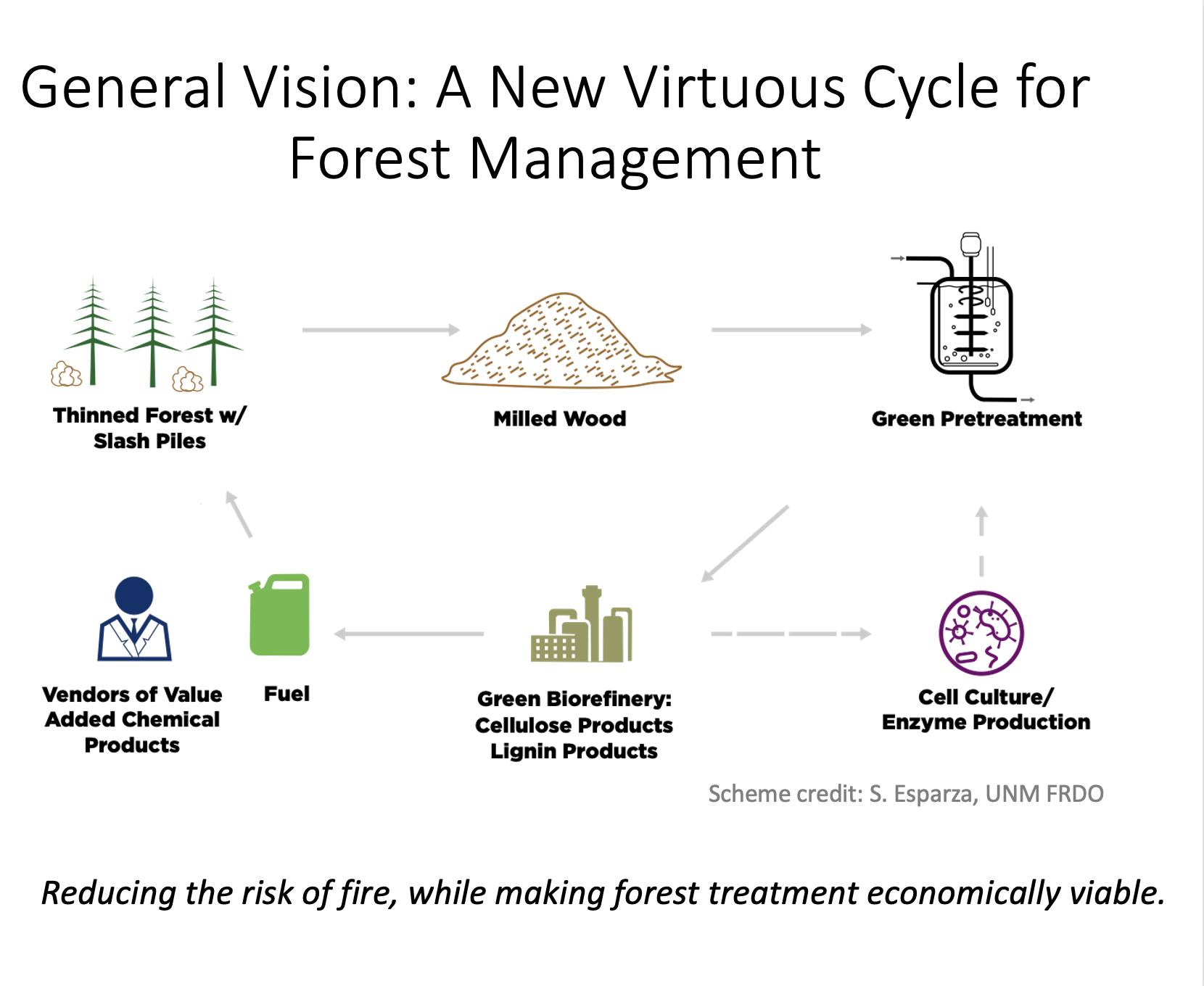Recent News
Not your mother’s nanomedicine: NIH grant targets safer medication for women
October 20, 2025
AI tensor network-based computational framework cracks a 100-year-old physics challenge
September 16, 2025
Postdoctoral research fellow wins 1st place in conference poster presentation
August 25, 2025
Engineering a new treatment for ovarian cancer
June 24, 2025
News Archives
UNM’s López wins one of six inaugural NSF TRAILBLAZER awards for wildfire project
August 23, 2024 - by Kim Delker

As a young man, Gabriel López worked for the U.S. Forest Service making new hiking and riding trails in and around the Pecos Wilderness. The trail crew would work and camp for weeks at a time maintaining and blazing new trails in the beautiful and remote mountainous area of Northern New Mexico.
Now López, Distinguished Professor in the Department of Chemical and Biological Engineering at The University of New Mexico, is breaking ground in a more figurative manner through a new National Science Foundation program that is helping researchers from six institutions across the country go where no one has gone before.
He is one of the recipients of the NSF Trailblazer Engineering Impact Award (known as TRAILBLAZER), an $18 million initiative that has the goal of helping researchers who have a strong history of creativity and finding innovative solutions to pursue new lines of research that will open unexplored territory. His project is titled “TRAILBLAZER: Overcoming the Lignin Barrier for Valorization of Forest Biomass — A New Paradigm for Mitigation of Catastrophic Wildfires.” The $3 million, three-year project begins Sept. 1.
Each NSF TRAILBLAZER award provides up to $3 million over three years for a project led by a single investigator in any engineering field or topic that differs from work they have done previously. Other institutions that received TRAILBLAZER awards were all private institutions: Harvard University, Massachusetts Institute of Technology, Johns Hopkins University, Boston University and Vanderbilt University.
López said the project he is leading is based on basic research in his areas of study in biochemical engineering, synthetic biology and materials science. While he has a record of significant accomplishments in these areas in the context of biomedical engineering, in his new project, he will be pursuing an entirely different application of biotechnology by developing new ways to process biomass that is generated in efforts to mitigate forest wildfires.
His project involves developing enzymatic methods to utilize thinned biomass waste, which is typically disposed of through “controlled burns” where forestry officials intentionally set fires to eliminate the waste. Controlled burns can be effective, but they are controversial and can result in ignition of wildfires instead of preventing them.
For López, this project is more than science or just another large grant to manage. It’s personal. The recent Calf Canyon/Hermit’s Peak Fire, which ultimately became the largest and most destructive wildfire in New Mexico’s history, ignited as a result of two different prescribed burn operations. This fire burned a large part of López’s beloved Pecos Wilderness and devastated many communities which continue to suffer adverse effects to the watersheds that sustain them.
Much of north central New Mexico is currently a “tinder box,” he said, because of the combined effects of climate change, tree die-off, and increased aridity. Wildfire prevention measures, especially in the western United States, have in recent years been focused on controlled burns, but they can and do go wrong with increased frequency due to instability in the weather.
By working with UNM’s Geospatial and Population Studies Center (UNM-GPS), Lopez’s proposal demonstrated the unique threat that wildfires pose in Northern New Mexico.
“There is a profound risk on the historical cultures in Northern New Mexico, which are some of the oldest cultures in the U.S.,” he said.
He said that many of the communities hit so hard by wildfires are agrarian, so the condition of the land is that much more crucial because it’s a matter of cultural survival.
López hopes that the new project will ultimately provide new technologies through bioengineering — ways to break down the biomass — that are better, safer and more profitable options than controlled burns.
He said several colleagues encouraged him to pursue this unique opportunity in the TRAILBLAZER program. Although he is the only principal investigator on this project, he spent considerable time talking with colleagues in his field as well as experts in the wildfire area to develop his ideas for his project.
One such connection was with Matt Hurteau, a UNM professor of biology, one of New Mexico’s foremost authorities on effects of climate change and wildfire on forests. He also consulted with David Peabody, a professor of molecular genetics and microbiology at UNM; Martin Kirk, a distinguished professor of chemistry at UNM; Nick Carroll, an associate professor of chemical and biological engineering; and Plamen Atanassov, a chancellor’s professor at University of California, Irvine (formerly at UNM). Another important connection has been with the National Renewable Energy Laboratory in Golden, Colo., where he has consulted with Davinia Salvachua, an expert in developing bioprocesses for utilization of biomass.
In addition, he is partnering with the New Mexico Forest and Watershed Restoration Institute at New Mexico Highlands University in Las Vegas, whose mission is to reduce catastrophic wildfires and restore ecosystems through partnerships and community engagement. López hopes to work with the institute to develop green bioengineering-based approaches that can be accepted and implemented by local communities and cultures.
The ultimate hope of this TRAILBLAZER project is to develop better solutions that consider many perspectives.
“We would like to be able to continue to build inroads into these communities and eventually come up with sustainable, green solutions to utilize biomass and help keep forests safe,” he said. “This issue is not going away. It’s a matter of New Mexico’s cultural survival.”
